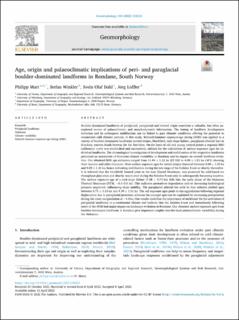| dc.contributor.author | Marr, Philipp | |
| dc.contributor.author | Winkler, Stefan | |
| dc.contributor.author | Dahl, Svein Olaf | |
| dc.contributor.author | Löffler, Jörg | |
| dc.date.accessioned | 2023-03-24T13:24:18Z | |
| dc.date.available | 2023-03-24T13:24:18Z | |
| dc.date.created | 2022-06-09T16:23:29Z | |
| dc.date.issued | 2022 | |
| dc.identifier.issn | 0169-555X | |
| dc.identifier.uri | https://hdl.handle.net/11250/3060381 | |
| dc.description.abstract | Boulder-dominated landforms of periglacial, paraglacial and related origin constitute a valuable, but often unexplored source of palaeoclimatic and morphodynamic information. The timing of landform development initiation and its subsequent stabilization can be linked to past climatic conditions offering the potential to reconstruct cold climatic periods. In this study, Schmidt-hammer exposure-age dating (SHD) was applied to a variety of boulder-dominated landforms (sorted stripes, blockfield, rock-slope failure, paraglacial alluvial fan) in Rondane, eastern South Norway for the first time. On the basis of old and young control points a regional SHD calibration curve was established and successively utilized for the calculation of surface exposure ages for individual landforms. The chronological investigation of development and stabilization of the respective landforms permitted an assessment of Holocene climate variability in Rondane and its impact on overall landform evolution. Our obtained SHD age estimates ranged from 11.44 ± 1.22 ka (ST-D2) to 4.09 ± 1.51 ka (AF1) showing their inactive and relict character. Most surface exposure ages for sorted stripes clustered between 9.88 ± 1.35 ka and 9.25 ± 1.21 ka, hence indicating stabilization during the late stage of the Erdalen Event or shortly thereafter. It is inferred that the blockfield formed prior to the Last Glacial Maximum, was protected by cold-based ice throughout glaciation and shortly reactivated during the Erdalen Event only to subsequently becoming inactive. The surface exposure age of a rock-slope failure (7.58 ± 0.73 ka) falls into the early phase of the Holocene Thermal Maximum (HTM, ~8.0–5.0 ka). This indicates permafrost degradation and/or increasing hydrological pressure negatively influencing slope stability. The paraglacial alluvial fan with its four subsites yielded ages between 8.73 ± 1.63 ka and 4.09 ± 1.51 ka. The old exposure ages point to fan aggradation following regional deglaciation due to paraglacial processes, whereas the younger ages can be explained by increasing precipitation during the onset neoglaciation at ~4.0 ka. Our results underline the importance of meltwater for the activation of periglacial landforms in a continental climate and indicate that the Erdalen Event and immediately following onset of the HTM had major impact on landscape evolution in Rondane. Our obtained surface exposure ages from boulder-dominated landforms in Rondane give important insights into the local palaeoclimatic variability during the Holocene. | en_US |
| dc.language.iso | eng | en_US |
| dc.publisher | Elsevier | en_US |
| dc.rights | Navngivelse 4.0 Internasjonal | * |
| dc.rights.uri | http://creativecommons.org/licenses/by/4.0/deed.no | * |
| dc.title | Age, origin and palaeoclimatic implications of peri- and paraglacial boulder-dominated landforms in Rondane, South Norway | en_US |
| dc.type | Journal article | en_US |
| dc.type | Peer reviewed | en_US |
| dc.description.version | publishedVersion | en_US |
| dc.rights.holder | Copyright 2022 The Author(s) | en_US |
| dc.source.articlenumber | 108251 | en_US |
| cristin.ispublished | true | |
| cristin.fulltext | original | |
| cristin.qualitycode | 2 | |
| dc.identifier.doi | 10.1016/j.geomorph.2022.108251 | |
| dc.identifier.cristin | 2030569 | |
| dc.source.journal | Geomorphology | en_US |
| dc.identifier.citation | Geomorphology. 2022, 408, 108251. | en_US |
| dc.source.volume | 408 | en_US |

